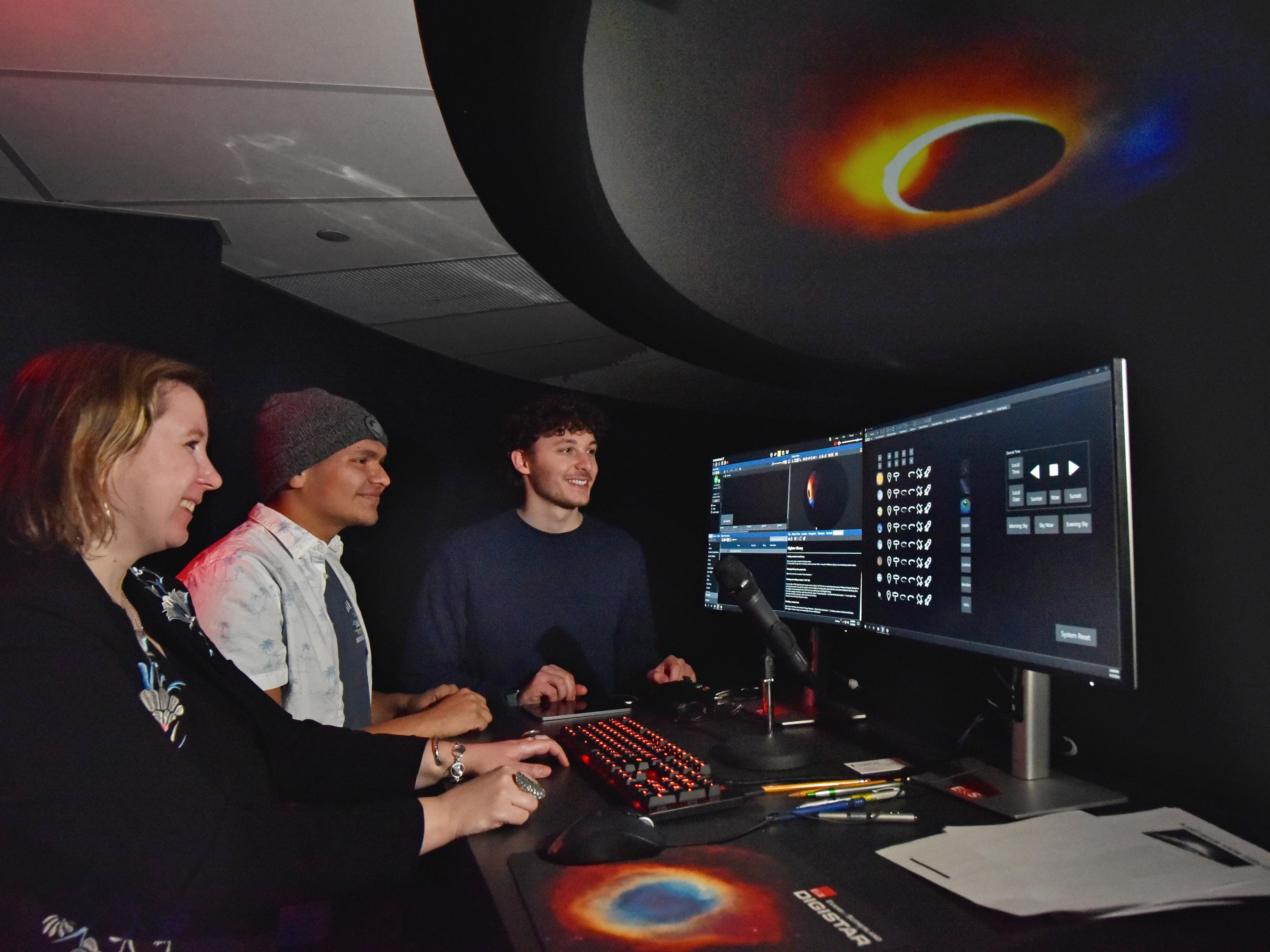From left, SUNY Oswego planetarium director Natalia Lewandowska speaks with students Jason Ruiz and Stephen Miskovsky about putting together planetarium shows. The Shineman planetarium will have shows during the upcoming April 8 total solar eclipse, which also provides a teaching and learning experience.
The once-in-a-lifetime solar eclipse over Central New York on April 8 offers the students working with the SUNY Oswego planetarium an opportunity to develop programs on this interesting phenomena.
For the day of the eclipse –- Monday, April 8 –- eclipse programs will take place at the second-floor Shineman Center planetarium, in shows supported by the Shineman Endowed Fund. As of this writing, all shows were sold out for that day.
But public shows regularly take place at 6 p.m. on Tuesdays and Thursdays during the academic year and have provided students with experience creating and presenting shows.
“We wanted to develop shows about what a solar eclipse is, how it works, what happens in space when we see an eclipse,” said Natalia Lewandowska, the planetarium director and a faculty member in the Department of Physics and Astronomy. “We talk about the various types of eclipses, and demonstrate why you don’t see a solar eclipse every month.”
For Stephen Miskovsky -- a physics major, with double minors in astronomy and mathematics -- putting together a planetarium show is an opportunity to learn about organizing this particular style of presentation.
“I’m trying to find the right words and get the parts together in an organized manner,” Miskovsky said. "It’s important to make it enjoyable.”
A meteorology major with double minors in astronomy and mathematics, Jason Ruiz is also working on eclipse-related content and finding it a learning experience.
“I’m learning how to keep the public engaged, how to ask them questions during the show, how to phrase the presentation in such a way that the public can understand,” Ruiz said.
The planetarium’s software was recently upgraded to Digistar, thanks to a grant from the Shineman Endowed Fund. These upgrades include the software itself, computers to run the program and updated Windows iterations for each new computer.
The upgrade allows those putting together programs with access to many catalogs as well as data and graphics from NASA (the National Aeronautics and Space Administration) and NOAA (the National Oceanic and Atmospheric Administration).
Exploring possibilities
For Miskovsky and Ruiz, studying astronomy fulfills longtime passions.
“I’ve always been interested in astronomy,” Miskovsky said, “I love exploring how many different secrets there are. Dr. Lewandowska will always get us to question things. We might not know the answer, but we love thinking about it.”
“I like how there are so many possibilities with the universe and how sometimes we can be so right about it and wrong about it at the same time,” Ruiz said. “There are so many questions to ask and exotic possibilities.”
They both took classes with Lewandowska and in this role, they are able to explore those possibilities and share their findings with the public.
“I previously created a show called ‘Cosmic Distances’ to give people a perspective about the distances in the universe in a way audiences can understand,” Ruiz said. “Another idea, as a meteorology major, would be to do a forecast of the solar system, look at the weather on different planets.”
“I previously did one about the different types of galaxies close to the Milky Way,” Miskovsky said. “Another show I’m working on is about comets. I know that people like comets, but they might not know how the tail forms or why they are out there.”
Whether for the eclipse or the regular weekly shows, Lewandowska knows that both the learning and the payoff are worth it.
“The public really enjoys the shows,” Lewandowska said. “And we love doing the shows.”
For more information on eclipse-related activities on the SUNY Oswego campus, visit oswego.edu/eclipse.




